
The site of an infamous B.C. mining disaster could get even bigger. This First Nation is going to court — and ‘won’t back down’
Xatśūll First Nation is challenging B.C.’s approval of Mount Polley mine’s tailings dam raising. Indigenous...
Some of you may have already seen the pictures.
Vast stands of old-growth Douglas firs and cedars, toppled. A grim-looking individual, perched atop a stump, staggering in size, its history harkening back to pre-colonial times, sap oozing beneath their feet.
British Columbians are near-immune to such images these days, with old-growth clearcutting a common sight and common practice. But something about the images coming out of Vancouver Island’s Nahmint Valley struck a chord.
A photo gallery posted by the Ancient Forest Alliance to Facebook in May of 2018 became a near-immediate viral sensation, being shared more than 4,800 times.
The organization, during an ancient forest expedition with the Port Alberni Watershed-Forest Alliance, found exceptionally large Douglas fir, including the fifth and ninth widest ever recorded in B.C., scattered among the remains of an extensive clearcutting operation.
The groups documented old-growth cedar stumps measuring a staggering 12 feet (3.7 metres) in diameter.
Something felt wrong about the scope and scale of the logging operations in the Nahmint Valley to the expeditioners.
And they were right.
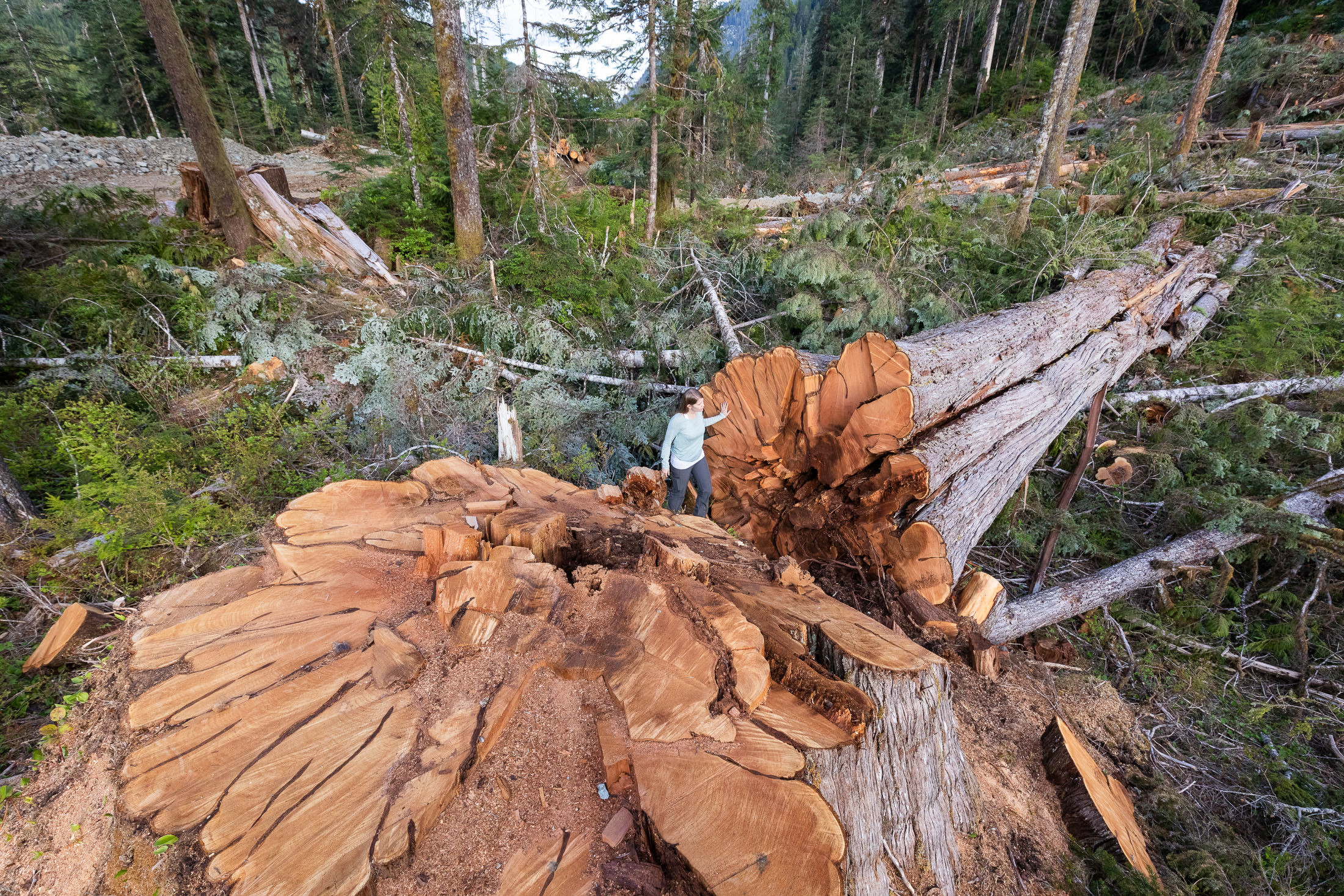
Ancient Forest Alliance campaigner Andrea Inness walks beside an enormous, freshly fallen western red cedar in a BC Timber Sales-issued cutblock in the Nahmint Valley near Port Alberni. Photo: TJ Watt
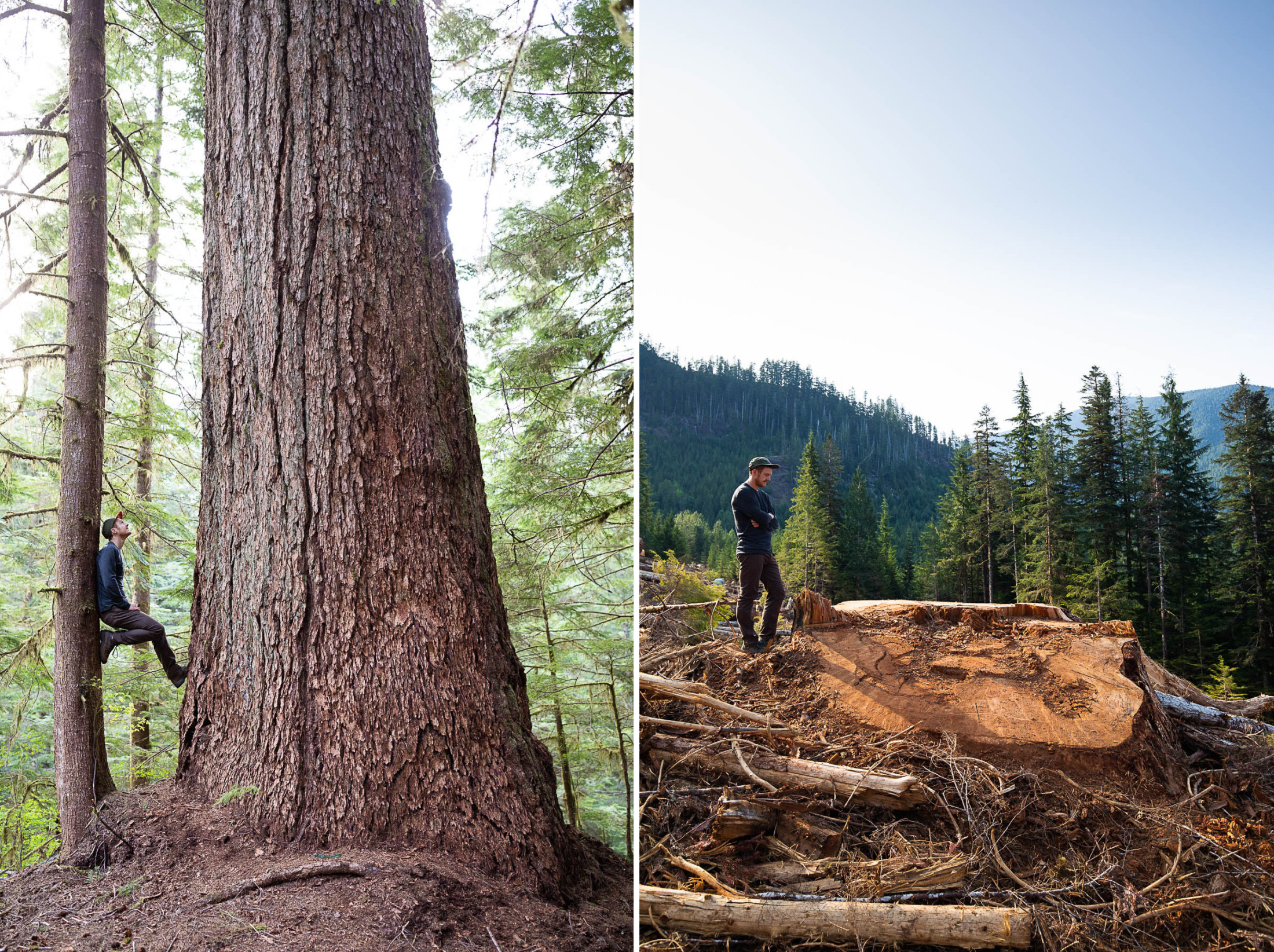
Before and after images of a massive Douglas fir tree in the Nahmint Valley. According to the B.C. Big Tree Registry, this Douglas fir was the ninth-largest of its kind in Canada. Photo: TJ Watt
Following their expedition, the Ancient Forest Alliance submitted a complaint to the compliance and enforcement branch at B.C.’s Ministry of Forests, Lands and Natural Resource Operations.
The findings of two subsequent investigations would confirm a deep-rooted suspicion that BC Timber Sales (BCTS), the government agency responsible for auctioning provincial logging permits, was thwarting protection rules and violating the principles of old-growth management plans.
The results of those investigations, obtained by the Ancient Forest Alliance through a Freedom of Information request, and reviewed by The Narwhal, show BC Timber Sales is not complying with rules designed to ensure sufficient old-growth forest is retained to avoid loss of biodiversity.
One of these investigations, conducted by a compliance and enforcement officer with the Ministry of Forests, recommended logging in the Nahmint Valley be halted, that future harvesting tenures be put on hold and that the agency should be prevented from establishing Nahmint old-growth management areas — which are created to protect old growth and achieve biodiversity targets — while problems are addressed to avoid legitimizing ongoing overcutting.
The second investigation was conducted outside the ministry and came to similar conclusions, documents released through the Freedom of Information request revealed.
Yet despite the clear and unequivocal tone of recommendations made by investigators in the summer of 2018, little change has been effected on the ground, where clearcutting in the Nahmint has continued unabated.
“None of the recommendations have been implemented,” Andrea Inness, Ancient Forest Alliance campaigner, told The Narwhal.
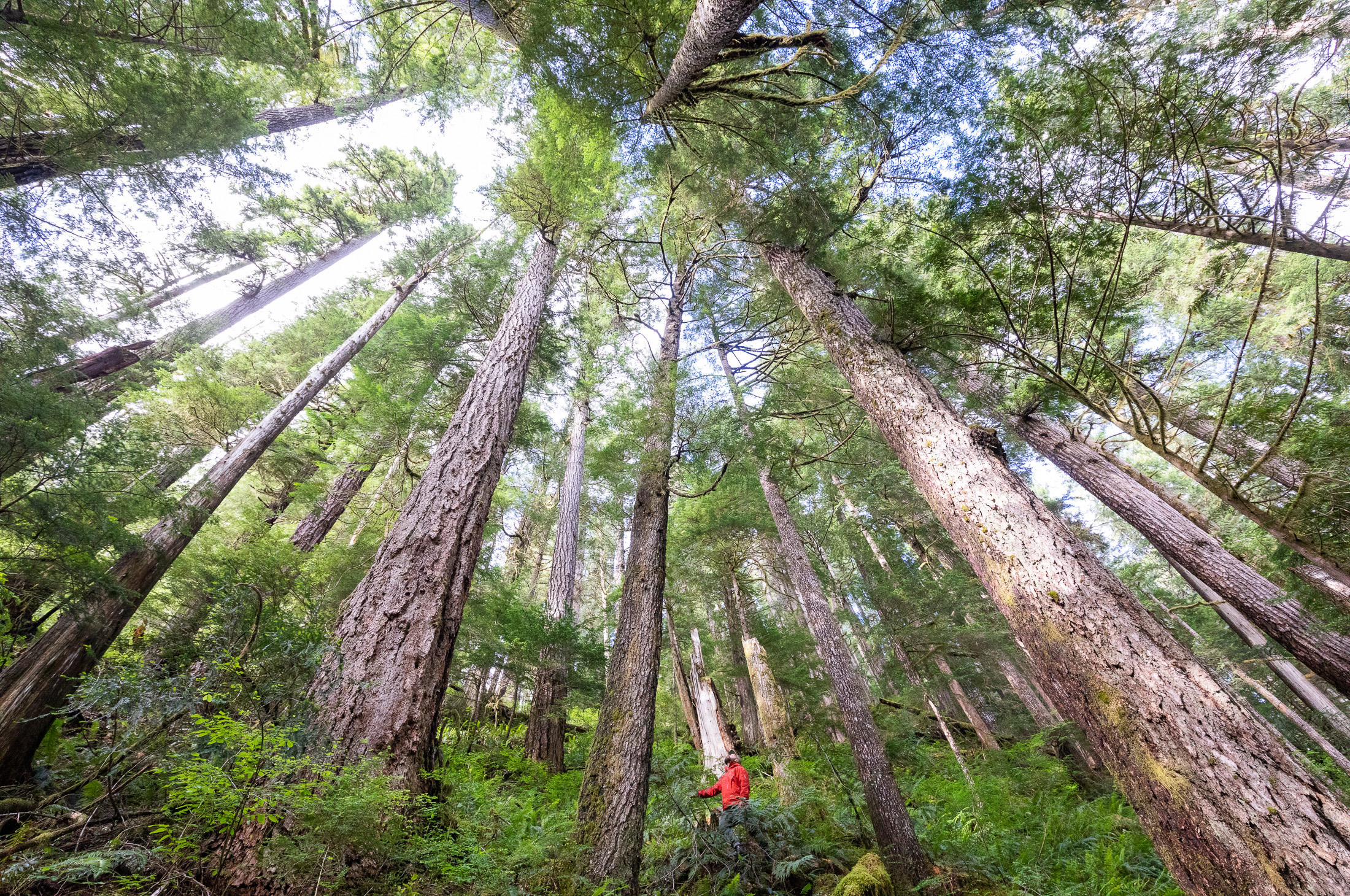
Before: An old-growth Douglas fir forest in a BC Timber Sales cutblock in the Nahmint Valley. An estimated 1 per cent of B.C.’s original old-growth Douglas fir remains today. Photo: TJ Watt

After: The same patch of Douglas fir after logging commenced. Photo: TJ Watt
The ministry report was conducted by senior compliance and enforcement specialist Bryce Casavant, who is no longer working for the provincial government.
“When I left government a few weeks ago, logging was continuing and there were 490,000 cubic metres scheduled to go to market by next spring,” Casavant told The Narwhal.
“Suffice it to say they are planning on extensive logging in that area despite the findings of the report,” he said.
Making the situation more frustrating, Casavant said he was told during the investigation that, in future, the compliance and enforcement branch would no longer investigate BC Timber Sales as government would not charge the organization.
“I got told at one point to close the investigation down and not to write a report and just send an internal memo and they would sort it out,” Casavant said.
BC Timber Sales, which was created in 2003 by the former BC Liberal government, manages 20 per cent of the province’s annual allowable cut, making it the biggest tenure holder in B.C.

An aerial view of the Nahmint Valley, July 2018. Photo: Jens Wieting / Sierra Club BC
When asked whether the compliance and enforcement branch is still able to investigate BC Timber Sales, a ministry spokeswoman, in an emailed response, said “compliance and enforcement can investigate BCTS and they can charge BCTS with infractions.”
But Casavant, who now works for Pacific Wild as a conservation policy analyst, said he was left with no doubt that investigations into the timber sales agency were not welcome.
BC Timber Sales and the law enforcement services at the Ministry of Forests, Lands and Natural Resource Operations are closely related and so, when problems arise, the answer is to come up with some fancy spin-doctoring, Casavant said.
“The problem is that there’s no true independence in the law enforcement service and forestry officers. The government will tell you that they are not related to BCTS, but in practice it’s not true. They all work out of the same office, side by side, day in and day out. They share the same deputy minister. There’s no true separation,” he said.
The timber sales agency is treated more favourably than other logging corporations, Casavant said.
“They are not treated the same as everyone else.”
The second, independent investigation found that planning for old-growth management areas appears ad hoc, “aiming to achieve the bare minimum required legally, rather than following good conservation design.”
“Our assessment suggests that the Nahmint demonstrates failure of professional reliance at maintaining publicly-agreed-upon values and priorities,” the report found.
Inness said it might be a good thing existing draft old-growth management areas in the Nahmint haven’t been legalized.
“The planning that went into the delineation of those OGMAs was flawed. When those areas were mapped, when those lines were drawn on maps, BCTS didn’t even look at ecosystem data or consider best practices,” she said.
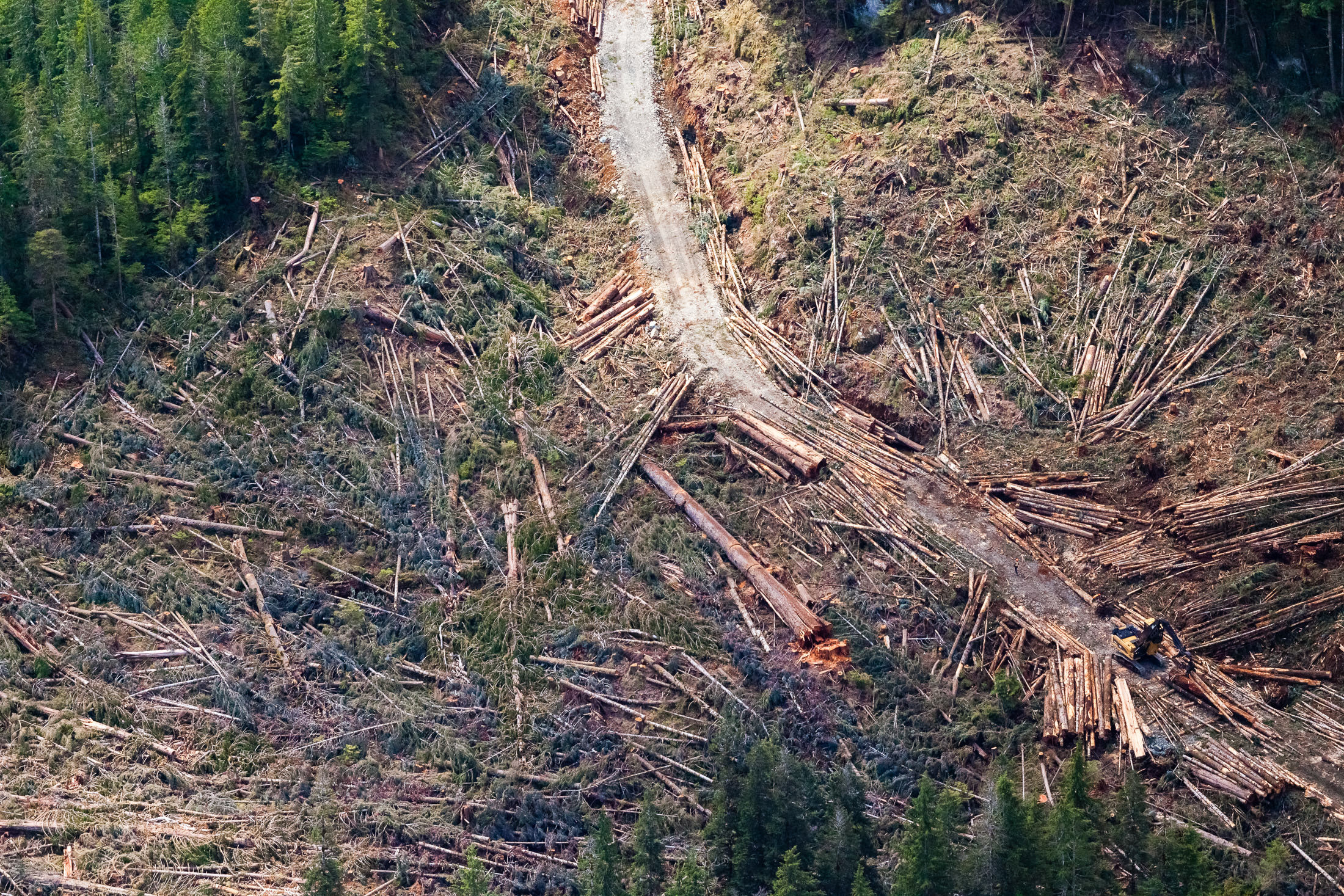
An aerial view of logging in the Nahmint Valley. Visible is a fallen Douglas Fir, measured as the ninth-largest of its kind in Canada. Photo: TJ Watt
Inness further suggested those draft areas were designed to support a bigger take for logging companies.
In addition to the two 2018 investigations, a Forest Practices Board investigation into the Nahmint is expected to be completed by the end of the year.
That investigation means the ministry cannot comment, according to a spokeswoman.
“The Forest Practices Board is currently investigating. That is all the information we can provide at this time,” ministry spokeswoman Dawn Makarowski said in an emailed response to questions from The Narwhal.
On the ground in the Nahmint Valley — under parcels auctioned by BC Timber Sales — giant trees continue to fall, threatening habitat for species such as the marbled murrelet and northern goshawk.
The agency has plans underway to auction off more than 400,000 cubic metres of old growth and, despite a specific recommendation to pause such actions, BC Timber Sales is moving to have draft Nahmint old-growth plans legalized.
In the formal complaint, submitted to the Ministry of Forests, Ancient Forest Alliance’s Inness wrote operations in the Nahmint appear to be in violation of the official land-use plan for Vancouver Island.
The intent of the Vancouver Island Land-Use Plan, established in 2000, is to retain a critical mass of old-growth.
“After walking through various recent cutblocks planned by BC Timber Sales in the Nahmint Valley, we believe BC Timber Sales’ forest stewardship plan fails to meet the results and strategies set out in the Vancouver Island Land Use Plan … that rare and underrepresented site series and surrogates be represented and protected,” Inness wrote.
The plan identified the Nahmint Valley as a special management zone, which prioritizes “environmental, recreational and cultural/heritage sites” rather than old-growth logging, but the investigation found that, although mapping of the valley’s unique biological features exists, the best available data was not used to protect unique ecosystems, retain biodiversity or protect large diameter trees.
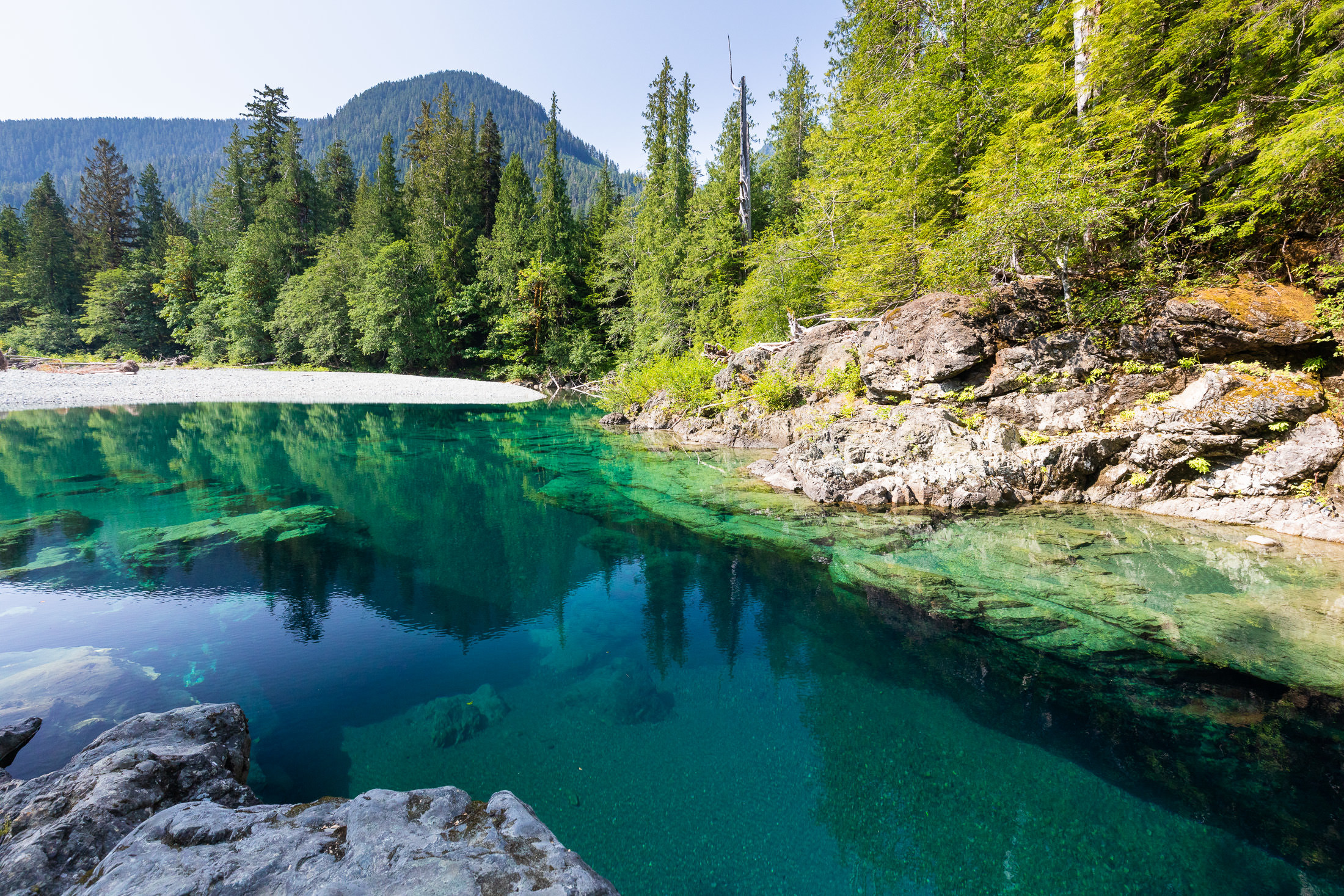
The crystalline waters of the Nahmint River. The valley is a popular outdoor recreation destination. Photo: TJ Watt
The ministry’s internal inspection found logging in the Nahmint suggests a “high likelihood of government noncompliance” with the land use plan.
Investigators concluded that there appear to be “legacy compliance issues” with timber harvesting in the Nahmint — meaning the overcutting probably dates back 18 years.
This failure to implement proper protections for the Nahmint is what led investigators to warn BC Timber Sales should not legalize new old-growth management zones until those failures have been addressed.
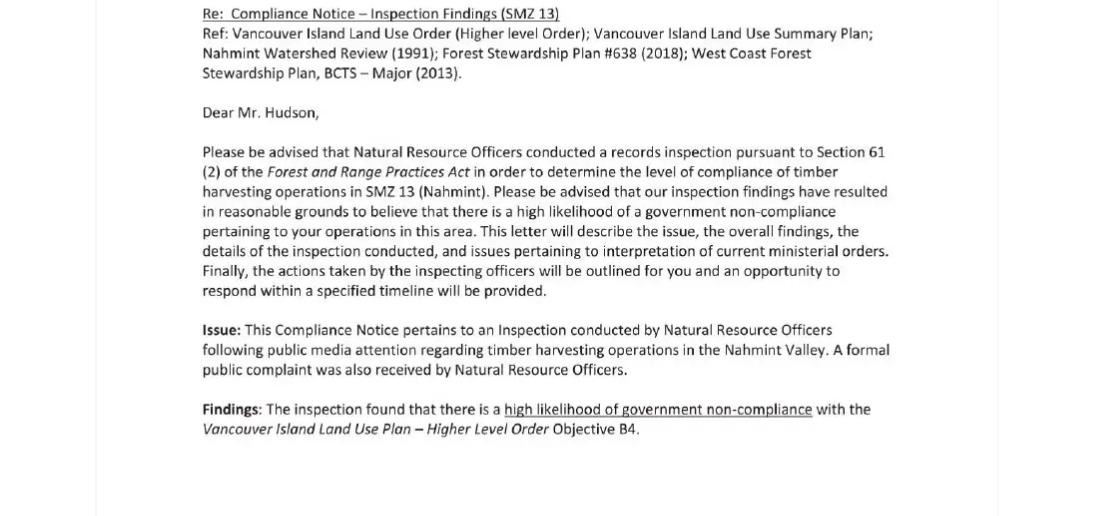
An email from Bryce Casavant to Don Hudson, BC Timber Sales manager. The email notes the Ministry of Forests investigation found a “high likelihood of government non-compliance” with regards to logging in the Nahmint Valley.
Yet, although there have been tweaks to the system, with small changes to cutblock locations, there is no indication that BC Timber Sales is planning to act on the investigation’s recommendations.
“It seems that eventually they will just carry on with business as usual,” TJ Watt, Ancient Forest Alliance co-founder, told The Narwhal.
In the internal documents detailing the investigations, a BC Timber Sales response claimed the agency’s planning is “generally” consistent with best practices and stated that logging in the Nahmint Valley cannot be in violation of the land use plan because the region’s forest stewardship plan was approved by a district manager.
That defence drew outrage from Inness.
“Approved forest stewardship plans do not override legal orders or government set objectives and can’t be used as a shield to allow non-compliant logging to occur,” she said.
“This is indicative of a truly corrupt system where, according to BCTS, logging can never be in non-compliance with the law, so long as a district manager signs off on it.”
The justification has Inness worried BC Timber Sales might be out of compliance with land-use plans for other areas of Vancouver Island.
“This has broader geographic implications as other special management zones and geographic areas managed by BC Timber Sales may have been — and continue to be — similarly mismanaged,” Inness said.
“They have been way over-logging and it opens up Pandora’s box. If it is happening in the Nahmint and they have completely misinterpreted the targets here, where else is it happening?” she asked.
Many contentious areas controlled by BC Timber Sales have high recreational value or are close to communities, which increasingly puts it at odds with local communities and First Nations. The Nahmint Valley is in traditional territories of the Hupacasath and Tseshaht First Nations.
Brandy Lauder, Hupacasath First Nation elected councillor, said she is not surprised that BC Timber Sales is ignoring recommendations to stop logging old growth.
“I am not shocked … This is the way government works,” said Lauder, adding that she is witnessing over-logging of old growth throughout the Alberni Valley, which is affecting the movement of wildlife as habitat is lost.
“Until the province actually tells BC Timber Sales not to log, they are going to continue. It will have to come from (Premier) John Horgan. They will just keep on operating and saying they are working on it. As long as they say they are working on it, they think they can just keep on going,” she said.
Last year, Hupacasath sent an open letter calling on the provincial government to halt old-growth logging in the Nahmint and work collaboratively with the band to protect the area’s old growth and, especially, the biggest trees and monumental cedars.
The letter to the Ministry of Indigenous Relations and Reconciliation called on the government to immediately extinguish all approved cutblocks in Hupacasath traditional territory and establish “best management practices for coastal legacy, monumental and old-growth trees.”
In July the province announced new protections for 54 old-growth trees listed in the B.C. Big Tree Registry, four of which are in the Alberni-Clayoquot region. But the plan drew criticism from those concerned with the scale of old-growth logging in some of the last intact zones on Vancouver Island.
In its announcement for the big tree protections, the province claimed 55 per cent of old-growth forests on Crown land in B.C.’s coastal region are protected from logging. Yet the majority of that protection exists in the Great Bear Rainforest while on Vancouver Island 1,300 hectares of new old-growth cutblocks have been approved in 2019.
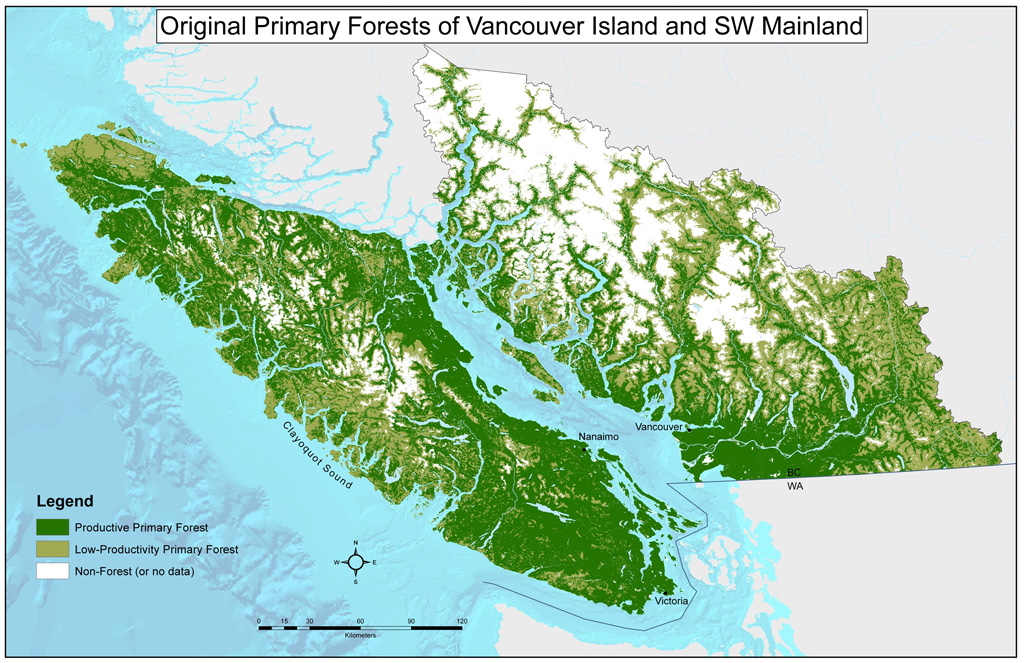
A map of pre-existing forests in Southern British Columbia. Map: Ancient Forest Alliance
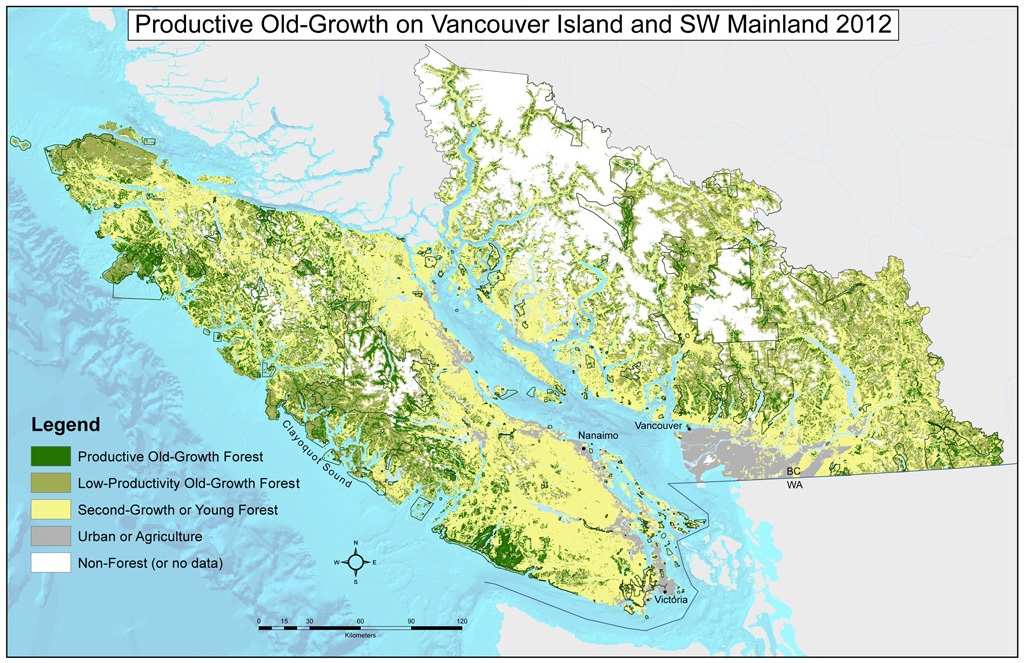
A map of remaining old-growth forest based on satellite data from 2012. Map: Ancient Forest Alliance
Long-time environmental advocate Vicky Husband, who worked to tighten up the Vancouver Island land-use plan before it was adopted in 2000, said she always feared the plan lacked teeth.
“We got some important changes, but not nearly enough was fully protected and now the ancient forests are in fragments over most of the island,” she said
“Nahmint is very, very contentious and what BCTS is doing, with the B.C. government’s backing, is promoting logging in some of the last areas left.”
Forests are being gutted and government can be misleading about how much ancient forest is left on Vancouver Island, Husband said.
“We have protected only 5.5 per cent of the original extent of ancient, big, old tree forests on Vancouver Island and just about one per cent of the dry Douglas fir forest. Imagine how we, a so-called progressive society, have done so little to protect the amazing forest heritage that we inherited,” she said.
“I am appalled. The public must act now to save what is left and then work to restore these incredible forest ecosystems.”
Inness said it appears government agencies are either willfully ignoring or misinterpreting B.C.’s already inadequate forestry rules.
“We have such a desperate need in this province for forestry to be done differently and they can’t even follow their own laws,” she said.
Casavant said ecologically rich places like the Nahmint Valley suffer irreparable harm when the province ignores its own rules.
“In today’s society it’s completely unacceptable for government to be involved in what should be classified as unlawful activities,” he said.
“If you are in non-compliance you can’t just say, ‘well maybe there’s a problem, but we are just going to go ahead.’ If you are in non-compliance and your plan requires you to follow the legislation, it is just wrong to go ahead.”
Casavant argues there should be legislation to ensure an impartial law enforcement service can investigate BC Timber Sales’ activities and charge them when necessary.
“BCTS should be treated, instead of a branch of the ministry, as a stand-alone Crown corporation,” he said.
Having an investigative branch embedded within the ministry is “absolutely ludicrous,” he added.
“We can’t have everybody working in the same office right from the planning stage to the approval stage to the investigation when something goes wrong.”
The government agency at the centre of B.C.’s old-growth logging showdown
During the summer the province asked for public feedback on the Forest and Range Practices Act, with changes expected over the next two years, but many fear changes will come too late to save the sizeable swaths of old growth needed, especially to protect biodiversity.
A report from the University of Victoria’s Environmental Law Centre says that, in high productivity areas such as valley bottoms, less than 10 per cent of the original old growth remains.
“On Vancouver Island, only about a fifth of the original, productive old-growth rainforest remains unlogged. More than 30 per cent of what remained standing in 1993 has been destroyed in just the last 25 years,” it says.
Get the inside scoop on The Narwhal’s environment and climate reporting by signing up for our free newsletter. When I visited my reserve, Moose Factory,...
Continue reading
Xatśūll First Nation is challenging B.C.’s approval of Mount Polley mine’s tailings dam raising. Indigenous...

As the top candidates for Canada’s next prime minister promise swift, major expansions of mining...

Financial regulators hit pause this week on a years-long effort to force corporations to be...

